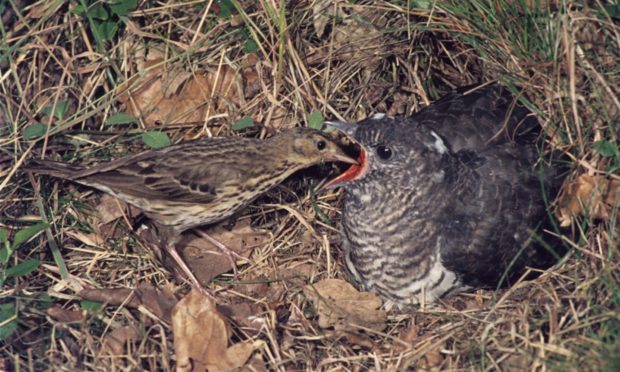In a wild glen near Elgol in Skye, a cuckoo newly arrived from the dark and impenetrable forests of central Africa, was calling its celebration to a Scottish May.
It is such a hypnotic sound; ‘coo-koo, coo-koo’; an echoing call, with a pitch and tone that can easily drift for a couple of kilometres, especially within the imposing amphitheatre of a Hebridean glen.
The cuckoo’s flute-like call penetrated every fold and gully of the hillside like a creeping mist, an evolutionary adaption to maximising the chance of attracting a female.
The cuckoo paused and then called again, a benign and haunting deliverance, but one that potentially sounds the death knell for the soon-to-hatch chicks of ground-nesting meadow pipits.
Once mated, the female cuckoo will seek a secluded look-out perch and patiently wait, perhaps for hours at a time, scanning the hillside with coiled predatory instinct, ready to unleash herself should she detect the tell-tale movement of an adult pipit.
Even the tiniest pipit flicker is enough to alert the cuckoo to the location of its nest hidden in a grassy tussock.
Then, down the cuckoo swoops to devour one of the pipit eggs and lay her own ticking time-bomb replacement.
Shortly after hatching, the baby cuckoo will push the pipit chicks or unhatched eggs out from the nest, so that the imposter now has the full attention of its unwitting foster parents.
A female cuckoo has the capability to lay each of her eggs in a dozen or more individual pipit nests, and once the dark task is completed, she will up-wings and be gone by the middle of July, heading back to the swamp and riverine forests of central Africa.
It is a truly remarkable piece of natural history, but even more astonishing is how the baby cuckoos, once reared by their pipit foster parents, know where to migrate to for the winter.
There are no adults to follow and learn from, instead through a complex programme wired into their genes, they just head south and unerringly arrive in central Africa.
Just been down to the Isle of Skye
During my recent short break here in this south-west corner of Skye, I frequently walked the shore at Loch Slapin, where small groups of great northern divers had congregated.
Each time the birds dived under, they did so as a group. I have observed this type of behaviour with birds such as mergansers and have concluded it is a hunting technique that increases the chances of catching fish by covering the seabed in a broad sweep, stirring-up creatures like a fishing trawl.
These divers were on the verge of migrating to their breeding grounds in Iceland, Greenland, and Canada.
It was mesmerising to be in among them, listening to their haunting, mournful cries drifting across the sea breeze; a wild resonance of the north, which provided the perfect accompaniment to the calls of the cuckoos rolling down from the nearby hills.
Info
Cuckoo eggs closely match the coloration of pipit eggs to aid deception. Cuckoos which specialise in different species, such as reed warblers, often have eggs that that are similar to their hosts too.











